Snowshoeing in Minnesota
In the land of lakes, it's easy and fun to get off the beaten path.

© Lauren Gagner
There are many good reasons to go off trail, and the chance to see moose definitely is one of them.
When we were at Bear Head Lake near Ely one January, we hiked first along a lakeside ski trail that was so packed we didn't need snowshoes.
But then the ranger mentioned she'd seen moose tracks in fresh snow near the park entrance, and we decided to go moose-tracking. Strapping on our snowshoes, we plunged from the road into deep woods.
It was a whole different world. The snow that barely covered our toes on the edge of the ski trail came up to our knees under the tree cover.
The moose had been everywhere, leaving dainty oval scat. Sometimes they'd made the tell-tale posthole tracks with their spindly legs, but more often they'd created cavernous holes as they wallowed through the snow.
We wallowed, too, but at least we were staying more or less on top of the snow as we followed the dips and rises of the glade. It was beautiful, with fresh snow outlining spruce tops and making waffle patterns on the boughs.
We didn't see any moose, but we felt a little like voyeurs as we stomped through their tucked-away hangout.
It was one of the best times I'd had on snowshoes, because I'd used them to go somewhere that otherwise would be off-limits. And by the time the two of us had shuffled through twice, we'd left a pretty decent path.
On a trail, your path is decided for you. Off trail, who knows where you'll end up — or what you'll see?
Minnesota has plenty of everything, marked and groomed snowshoe trails as well as remote wilderness.
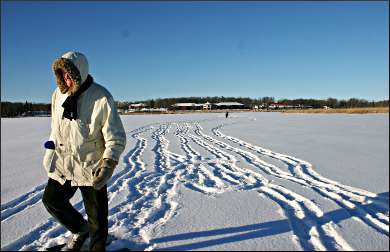
© Beth Gauper
More than 30 Minnesota state parks rent snowshoes for $6 a day. Many parks also offer guided snowshoe hikes, during which snowshoe use is free (register in advance).
And many state parks offer guided hikes and snowshoe-making workshops.
The problem with popular state parks is that trails there often are quickly packed down. Minnesota's state natural areas — protected spots that are lovely, but without services — often are a better bet. They're small, but then, you can't travel all that far on snowshoes, anyway.
Here are some of the best places to snowshoe in Minnesota. For conditions, check the weekly DNR snow-depth report.
For candlelight events, see Ski or snowshoe by candlelight.
And for other good places next door, see Snowshoeing in Wisconsin.
North-central lakes
Itasca State Park north of Park Rapids. There's no bad place to snowshoe in this beautiful park, but the 3.2-kilometer Dr. Roberts Nature Trail, 3.1-kilometer Mary Lake Trail near Douglas Lodge and 1.8-kilometer Schoolcraft Trail near the headwaters are groomed for snowshoeing, and there's a 3/4-mile twinkle-lighted trail for nighttime snowshoeing.
Within the park, Itasca Wilderness Sanctuary state natural area includes the Bohall Wilderness Trail.
For more, see Itasca in winter.
Deep Portage Learning Center near Hackensack. At this large reserve an hour north of Brainerd, the public is welcome to snowshoe on nearly 10 square miles of forest set on rolling glacial moraine, with seven lakes. There are snowshoe as well as ski trails; pick up a map in the lodge.
For naturalist-led snowshoe hikes, the snowshoes are supplied.
For more, see Playground in the woods.

© Beth Gauper
Uppgaard Wildlife Management Area near Crosslake. Just off the Paul Bunyan Scenic Byway, this 110-acre non-game wildlife is very quiet in winter and a good place to look for wildlife. It's nine miles east of Minnesota 371 and Jenkins on County Road 16.
There are other good spots along the 54-mile byway, which winds around the Whitefish Chain. The Veterans Walking Trail also is along County Road 16, 2½ miles east of Jenkins.
For more, see Brainerd in winter.
Northland Arboretum in Brainerd. This 540-acre preserve, also a trailhead on the Paul Bunyan State Trail, has many 100-foot red pines and is frequented by fox, beaver, deer, timber wolves and bears.
It also has nearly 20 kilometers of ski trails, some lighted nightly. Trails are open from sunrise to sunset, and the visitors center is open Monday through Friday. A parking donation of $5 is requested.
From Thanksgiving evening until the Saturday after New Year's, the arboretum also features the Sertoma Club's Winter Wonderland, a lighted holiday display, and admission is $15-$20 per car.
The arboretum is in the northeast corner of the junction of 371 and 210 in Baxter.
State parks: In north-central lakes country, these state parks rent snowshoes: Itasca, Lake Bemidji, Mille Lacs Kathio, Lake Carlos near Alexandria, Lindbergh in Little Falls and Crow Wing just south of Brainerd.
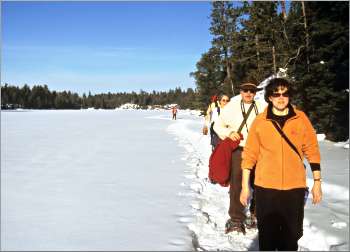
© Beth Gauper
Ely
North Arm trails of Burntside Lake. These hilly trails are popular for skiing and hiking, too. From the trailhead, several loops wind through magnificent old-growth forest and up rocky ridges for spectacular views of surrounding lakes and forests.
They're reached by turning onto North Arm Road or County Road 644 from the Echo Trail north of town.
North Hegman Lake pictographs. It's three kilometers across South Hegman Lake to these ancient red figures.
Drawn on rock 500 or 1,000 years ago, they depict a moose, an otterlike animal, a figure that may be human or superhuman and perhaps some constellations — no one knows for sure. Park off the Echo Trail or County Road 116, 15 miles north of town.
There are guided snowshoe hikes during Ely's Winter Festival in early February.
If the sun is strong, the lake can get slushy, so wear waterproof boots.
For more, see Winter in Ely.
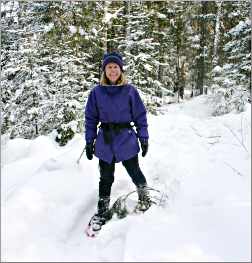
© Torsten Muller
Bear Head Lake State Park. This quiet park between Ely and Tower, seven miles south of Minnesota 169, is a good place to get off trail and perhaps spot a moose. It rents snowshoes and has camper cabins and a guesthouse for rent.
For more, see Ensconced in Ely.
Duluth
Hartley Nature Center. There are more than 10 miles of hiking trails in this rolling, wooded preserve, bisected by the Superior Hiking Trail.
It has 70 pairs of rental snowshoes, traditional wooden ones for adults and youths and metal shoes with teeth for preschoolers through first-graders. Cost is $10 for non-members.
The center is just north of the University of Minnesota-Duluth campus, off Woodland Avenue/Skyline Parkway.
Superior Hiking Trail. Now, 50 miles of the Superior Hiking Trail stretch from the Wisconsin border to the northeast end of Duluth. In Duluth, it follows roughly the same ridges and glacial beach terraces used by Skyline Parkway.
Many of the sections may be packed down, but the scenery can't be beat. One of the best places to snowshoe (if you don't mind hills) is Magney-Snively Park, on Skyline Parkway just west of Spirit Mountain.
For more, see Hiking in Duluth.
North Shore
There are dozens of good places to snowshoe along Lake Superior.
The last three miles of the Duluth-Two Harbors section of the Superior Hiking Trail mostly follows Silver Creek, lined by low cliffs. To get to the trailhead, take County Road 3 from Betty's Pies, just east of Two Harbors, and turn onto County Road 301.
Four miles north of Gooseberry Falls State Park, at the mouth of the Split Rock River, there's a parking area that's the start of the five-mile Split Rock River loop of the Superior Hiking Trail.
Not far from the trailhead on the west side of the river, there's a 20-foot blue-ice waterfall on a creek, around the corner from the first bridge.
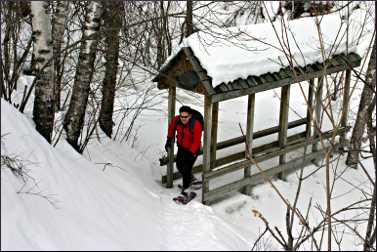
© Beth Gauper
Five miles west of Schroeder, there's a one-mile interpretive trail through the lovely Sugarloaf Cove preserve. Two miles farther west, there's a 1½-mile hike along the Caribou River past Caribou Falls to the covered bridge over Crystal Creek and back.
Naturalists at Gooseberry, Tettegouche and Split Rock Lighthouse state parks lead frequent snowshoe hikes. For times, check the state-park events calendar. Tettegouche and Split Rock Lighthouse rent snowshoes.
For more, see North Shore by snowshoe.
Gunflint Trail
You can snowshoe nearly anywhere, but resorts on the Gunflint Trail offer snowshoeing on 25 miles of marked and groomed trails.
You can also snowshoe into the Boundary Waters Canoe Area Wilderness; be sure to fill in a free day-use permit. You can plunge in anywhere, but if you're looking for a trail, you can reach the Boundary Waters via the 41-kilometer Banadad Ski Trails.
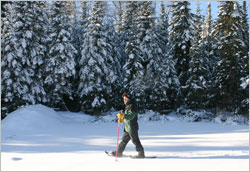
© Beth Gauper
George Washington Memorial Pines. This preserve, just six miles up the Gunflint Trail from Grand Marais, is a good place to track small animals. There's a three-mile trail through swamp and pines.
Northern Light Trail. Thirteen miles from Grand Marais, this one-mile trail climbs up Blueberry Hill to its bald basalt pate and a panorama of the lake and Brule River stretching into the distance. Sometimes the parking lot isn't plowed, however.
Honeymoon Bluff Trail. Sixteen miles farther, turn off on County Road 66 and drive two miles, just past the Flour Lake Campground.
From here, this trail climbs wooden steps to an iron-streaked cliff high above the labyrinthine waters of Hungry Jack Lake and, beyond, West Bearskin Lake. It's especially lovely at sunset.
Caribou Rock Trail. Another four miles farther, turn onto County Road 65/Hungry Jack Road and go to the trailhead. The trail leads to overlooks of West Bearskin Lake and Moss Lake.
Twin Cities area
The problem with snowshoeing in the Twin Cities is that so much of it already is packed by the time you get there. So try to head out while the snow is fresh.
The University of Minnesota's Center for Outdoor Adventure, in the basement of the University Rec & Wellness Center at 123 Harvard St. SE, rents snowshoes. Rentals must be picked up and returned Monday-Friday between 10 a.m. and 6 p.m. or Sunday from noon to 5 p.m. To reserve, call 612-625-8790.

© Beth Gauper
Mississippi River Gorge in Minneapolis. Trails follow both sides of the river on the only place where the river cut a gorge, between the Franklin and Ford Parkway bridges. Duck down onto the Winchell Trail, on the west bank between Franklin Avenue and 44th Street.
Minnehaha Creek in Minneapolis. Much of the 22-mile creek from Lake Minnetonka to Minnehaha Park in Minneapolis freezes, and in Minneapolis, public parkland lines both sides of the creek.
For more, see Walking on water.
Theodore Wirth Park Winter Recreation Area in Minneapolis. Snowshoers can use the 4.36-mile mountain-biking trail near Wirth Beach in this large, leafy park in the northwest corner of the city. It rents snowshoes.
Three Rivers Park District. This large district in west suburban Minneapolis, named for the Minnesota, Mississippi and Crow rivers, maintains 38 miles of snowshoe trails at 11 parks and reserves.
It offers dozens of snowshoe hikes, some by full moon, some by candlelight, some for beginners or just for women. Snowshoes are provided, and most fees are $5.
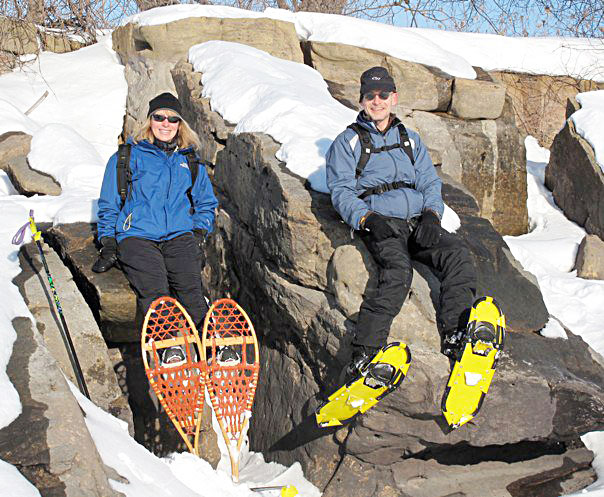
© Lauren Gagner
It rents snowshoes for $6 plus tax at Richardson Nature Center at Hyland Hills in Bloomington, Elm Creek in Maple Grove, Baker in Maple Plain, Carver in Victoria and four other parks. Snowshoes are provided for participants in guided hikes.
Minnesota Valley National Wildlife Refuge. This eight-parcel preserve in the southern and southwest suburbs of Minneapolis holds frequent snowshoe hikes, with snowshoes provided at no charge.
Many of the hikes are from the Bloomington Visitor Center, near the Mall of America, and the Rapids Lake Education and Visitor Center, near Carver. The Louisville Swamp, off Minnesota 169 near Shakopee, is a popular place to snowshoe.
Bruce Vento Nature Sanctuary in St. Paul. The Trust for Public Land calls this area on the east side of downtown one of the nation's 7 Spots for Snowy Fun.
Carpenter St. Croix Valley Nature Center near Hastings. This 425-acre preserve has hiking trails through pines, oak savanna, restored prairie and in wooded ravines along the St. Croix River. It hosts guided moonlight hikes, $7, with snowshoes provided.
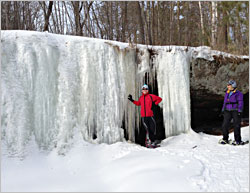
© Beth Gauper
Lake Maria State Park near Monticello. This park, right off I-94 an hour west of the Twin Cities, maintains three miles of trails for snowshoeing, and snowshoers can go off on their own in this stand of Big Woods.
State parks: Within an hour of the Twin Cities, these parks rent snowshoes: Lake Maria, Afton, Wild River near Taylors Falls, and St. Croix near Pine City.
Southeast Minnesota
In many of the last few years, southeast Minnesota has been hit by more blizzards than the north woods, giving it reliable snow.
Frontenac State Park between Red Wing and Lake City. This bluffside park on the Mississippi River rents snowshoes and offers snowshoeing on a variety of terrain, in ravines and on the bluff top.
Whitewater State Park between Rochester and Winona. This large, picturesque park, surrounded by limestone bluffs, rents snowshoes and has many areas where snowshoers can walk, along streams and up to overlooks.
State parks: Great River Bluffs near Winona and Nerstrand Big Woods near Northfield also rent snowshoes.